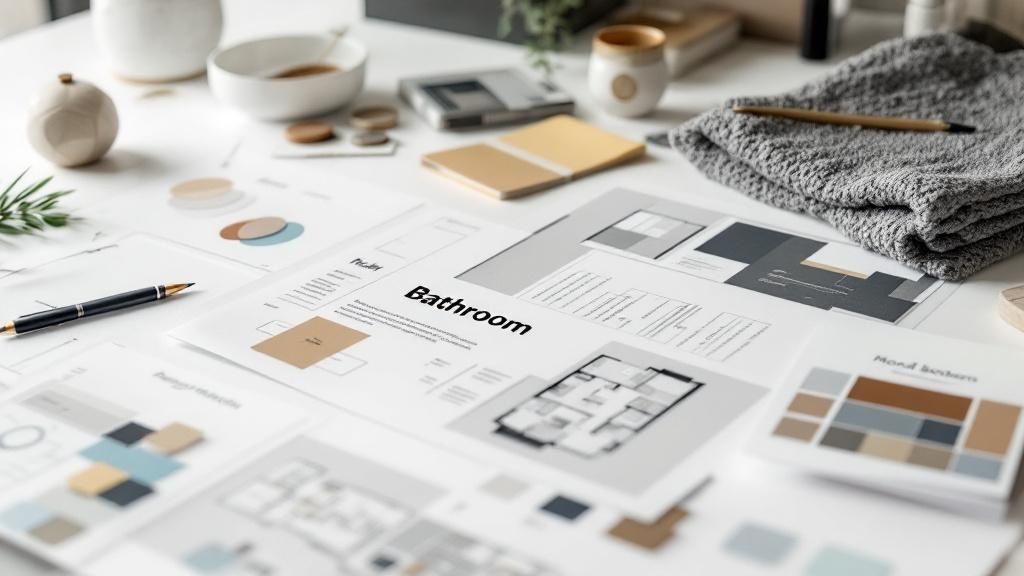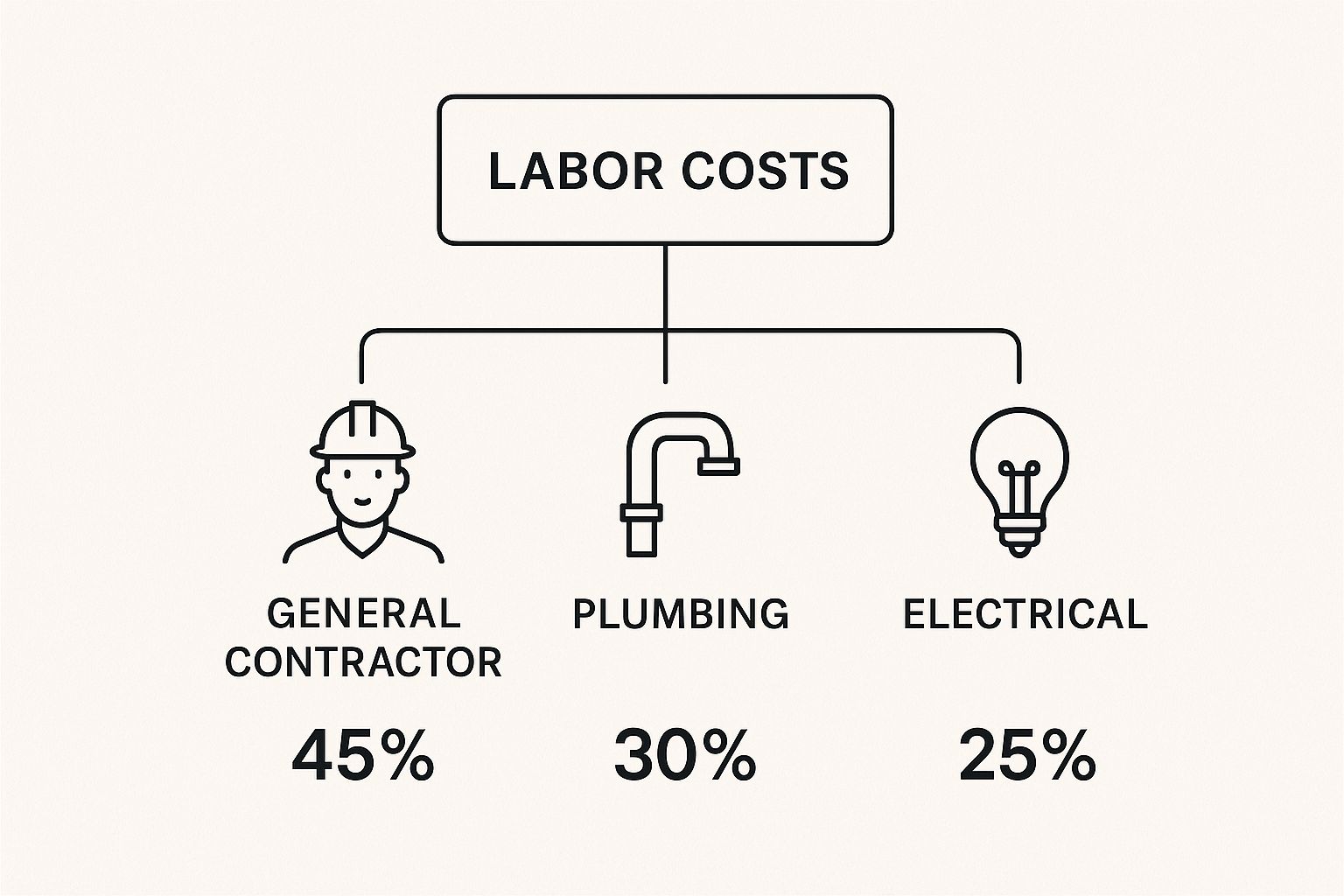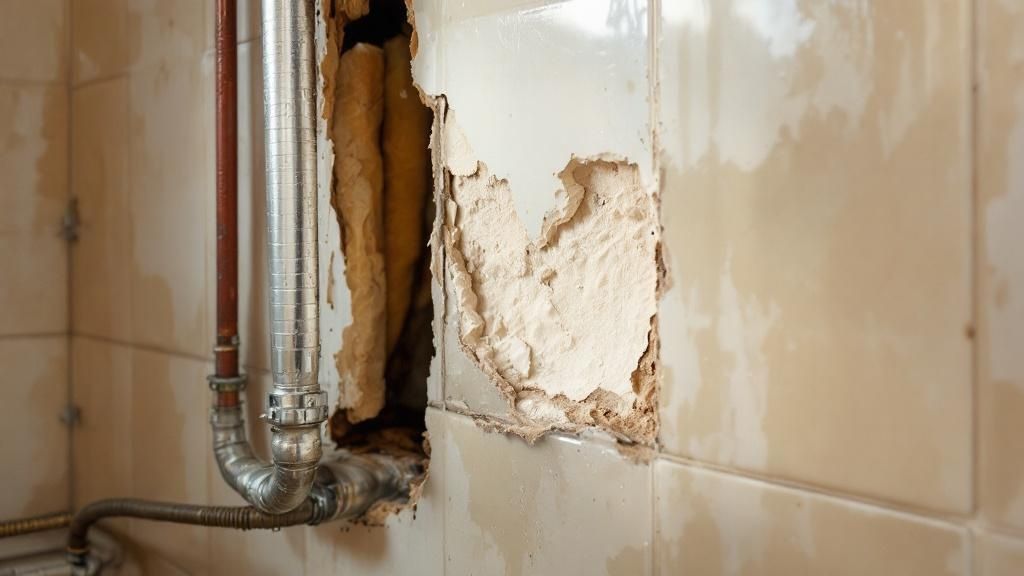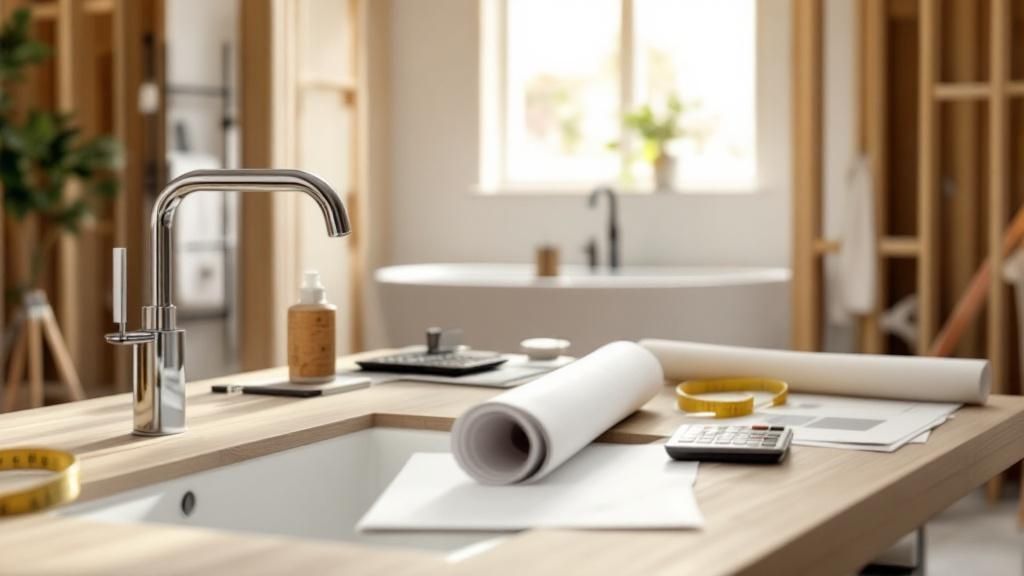Planning a bathroom remodel in a place like Berkeley or Oakland? The first question on every homeowner's, builder's, or architect's mind is always the cost. A quick cosmetic refresh in the Bay Area can start around $15,000, but a full-scale, down-to-the-studs luxury project can easily sail past $50,000.
The final tally really comes down to three key factors: the cost of labor, your choice of materials, and the scope of the changes. This guide provides a detailed bathroom renovation cost breakdown to help you set a realistic budget for your project.
What Does a Bathroom Renovation Really Cost in the Bay Area?

Getting a handle on the financial scope of your bathroom remodel is the absolute first step. While national averages are a fine starting point, the Bay Area market is a different beast altogether. Higher labor rates and a strong demand for quality materials significantly shape the final cost here.
Nationally, you might see an average cost around $12,118, with a typical range from $6,639 for light updates to over $17,620 for something more involved. But in our local market, labor alone can eat up 40% to 65% of the total budget. If you're curious about the broader trends, you can read more about national remodeling cost trends.
Setting Realistic Financial Goalposts for Your Project
To build an accurate budget, it helps to think about remodels in three distinct tiers. Each one comes with a different price tag and level of work, giving you a clear financial baseline for your Bay Area project.
Bay Area Bathroom Renovation Cost Estimates at a Glance
Here’s a quick look at what you can expect to invest for different levels of bathroom remodels in the Berkeley, Oakland, and greater San Francisco area. This table should help you zero in on a budget that feels right for your goals.
| Remodel Tier | Typical Bay Area Cost Range | Key Features |
|---|---|---|
| Cosmetic Refresh | $15,000 – $25,000 | New paint, vanity, light fixtures, faucets. Layout stays the same. |
| Full Renovation | $25,000 – $45,000 | Replaces everything: tub, tile, toilet, vanity, flooring. No major plumbing moves. |
| Luxury Overhaul | $50,000+ | Complete gut, layout changes, moving plumbing, high-end materials, custom work. |
This breakdown gives you a solid framework, allowing you and your contractor to make smart decisions that align your vision with your wallet right from the get-go.
Understanding the Three Tiers of Renovation
-
Cosmetic Refresh (Basic Tier): This is all about surface-level upgrades without touching the layout. Think a fresh coat of paint, a modern vanity, new light fixtures, and a stylish faucet. It's the most wallet-friendly way to breathe new life into your space.
-
Full Renovation (Mid-Range Tier): This is what most people picture when they think "remodel." It involves replacing almost everything—the tub, tile, toilet, vanity, and flooring—but keeping all the plumbing and electrical right where they are. You get a massive transformation in style and function.
-
Luxury Overhaul (High-End Tier): A luxury project means taking the space completely down to the studs. This tier often involves reconfiguring the layout, like moving plumbing to create a larger walk-in shower, and bringing in premium materials like natural stone, custom cabinetry, and top-of-the-line fixtures.
Key Takeaway: The single biggest factor that drives up cost is changing the bathroom's footprint. Moving a toilet, shower, or sink requires extensive plumbing and electrical work, which dramatically increases labor expenses and can trigger complex permitting requirements in cities like Berkeley or Oakland.
Once you know which tier your project falls into, you can set a practical budget. This clarity empowers you, your builder, or your architect to make informed choices on materials and scope, ensuring your dream bathroom doesn't turn into a financial nightmare.
Breaking Down Your Budget: A Component-by-Component Guide
A renovation budget isn't just one big, scary number; it's a collection of individual costs that add up to your total investment. For any contractor, architect, or homeowner in the Bay Area, getting a handle on a detailed bathroom renovation cost breakdown is key to planning accurately and avoiding surprises.
When you dissect your project into its core components, you can see exactly where your money is going. This visibility allows you to make smart trade-offs. In a high-cost market like ours, understanding each piece of the budget is essential.
Labor: The Biggest Slice of Your Budget Pie
In almost every Bay Area bathroom remodel, labor is the single largest expense, often consuming 40% to 65% of the total budget. This cost covers a team of skilled trades—plumbers, electricians, tilers, and painters—all working in a coordinated effort. To get a project done right and up to code in cities like Berkeley and Oakland, you absolutely need licensed professionals.
This graphic provides a typical breakdown of how labor costs are distributed among the key trades on a project.

The general contractor typically manages the largest portion of the labor budget. This reflects their role in orchestrating the entire project, from scheduling subcontractors to ensuring quality and compliance. Specialized, high-stakes jobs like plumbing and electrical follow close behind.
Key Cost Categories in a Typical Renovation
Beyond labor, your budget is spread across several other crucial categories. Here’s a look at the usual suspects and the portion of the budget they typically claim.
- Demolition and Preparation (3-5%): This is where the action starts, involving the removal of old fixtures, tile, flooring, and sometimes drywall. It must be done carefully to avoid damaging plumbing or structural elements you plan to keep.
- Plumbing and Electrical (15-25%): This is a critical—and often expensive—phase, especially in older Bay Area homes. Moving a toilet even a few feet requires a licensed plumber, while adding new lighting or a ventilation fan means bringing in an electrician to meet modern safety codes.
- Fixtures (15-20%): This category includes your toilet, sink, faucet, tub, and shower system. The cost can swing wildly depending on your selections, from solid, builder-grade options to high-end designer pieces.
- Finishes (20-30%): This is what defines the look and feel of your new bathroom. We're talking wall and floor tile, countertops, the vanity, cabinetry, and paint. Splurging on high-end materials like natural stone will push this percentage higher.
- Permits and Fees (1-3%): Don't forget to budget for the city. In places like San Francisco, any project that touches plumbing or electrical systems will require permits and inspections.
Pro Tip: In older homes, common in Berkeley and Oakland, it’s not unusual to uncover outdated galvanized pipes or knob-and-tube wiring during demolition. Addressing these issues is non-negotiable for safety and will add to your plumbing and electrical costs.
The single biggest decision that will impact your budget is changing the bathroom's layout. If you want to keep costs under control, the most effective strategy is to keep the plumbing fixtures right where they are. A straightforward fixture swap is vastly more affordable than reconfiguring the entire space.
By understanding this breakdown, you can work with your contractor to allocate funds where they matter most to you. Having access to a wide range of building materials for the San Francisco Bay Area lets you compare options and find the perfect balance between style, function, and cost.
Understanding Skilled Labor Costs in the Bay Area

Here in the competitive Bay Area market, skilled labor is almost always the largest part of any bathroom renovation budget. You can select the most beautiful materials, but it's the expertise of professionals that brings your vision to life—safely and correctly. According to the National Association of Home Builders (NAHB), a staggering 83% of homeowners hire professionals for their renovations, making it critical to budget for the right team.
The Key Players on Your Bay Area Renovation Team
A successful bathroom remodel is a team sport, relying on a coordinated crew of specialists. Each trade has a specific role, and their rates in cities like Oakland and San Francisco reflect their high level of expertise and demand.
- General Contractor (GC): The GC is the project manager, overseeing the entire job from hiring trades to ensuring quality control. They typically charge a fee of 15-25% of the total project cost.
- Plumber: A non-negotiable expert for any work touching your water supply, drains, and fixture installations. In the Bay Area, a licensed plumber will run from $100 to $200+ per hour.
- Electrician: Essential for installing lighting, GFCI outlets, and exhaust fans, and ensuring everything is up to current safety codes. Their rates are similar to plumbers, generally landing in the $90 to $180 per hour range.
- Tile Setter: An artisan whose meticulous work defines the final look of your bathroom. Expect to pay $15-$30+ per sq. ft. for installation, depending on the tile and pattern complexity.
Estimated Bay Area Labor Rates by Trade
Here’s a closer look at what you can expect to pay for various professionals in the Bay Area.
| Trade Professional | Typical Bay Area Hourly Rate | Common Project Scope |
|---|---|---|
| General Contractor | 15-25% of Total Project Cost | Overall project management, scheduling, permits, quality control |
| Plumber | $100 – $200+ | Moving water/drain lines, installing toilets, sinks, showers, tubs |
| Electrician | $90 – $180+ | New wiring, lighting installation, exhaust fans, GFCI outlets |
| Tile Setter | $15 – $30+ per sq. ft. | Floor tile, shower walls, backsplashes, waterproofing prep |
| Drywall/Painter | $60 – $100+ | Wall repair, new drywall installation, priming, painting |
| Demolition Crew | $50 – $85+ | Tearing out old fixtures, flooring, tile, and cabinetry |
These rates are estimates and can fluctuate based on job specifics and experience. However, they provide a solid baseline for what to expect in the Berkeley and Oakland markets.
The GC Decision: To Hire or Not to Hire?
For a seasoned DIYer, acting as your own general contractor might seem like a smart way to save the 15-25% GC fee. However, this path requires a serious investment of time, industry knowledge, and project management skills to keep everything on track.
Key Insight: Hiring a licensed and insured General Contractor gives you a single point of accountability. They juggle complex schedules, troubleshoot issues, and ensure all work complies with local Berkeley and Oakland building codes, protecting you from liability and costly mistakes.
Ultimately, investing in qualified professionals is the surest way to get the job done to a high standard, on schedule, and safely. Once your team is lined up, you can explore the wide variety of durable materials perfect for contractors to ensure your project stands the test of time.
How Your Material and Fixture Choices Shape the Final Cost
After labor, the next major factor in your bathroom renovation cost breakdown is the materials and fixtures you select. This is where your design vision takes shape and where your choices have the biggest impact on your budget.
Every item, from the tile you walk on to the faucet you use every day, comes in a huge range of prices. Your material choices give your bathroom its personality. Are you aiming for a sleek, modern vibe common in San Francisco homes, or something more classic to fit a historic Berkeley property?
Understanding Price Tiers for Key Bathroom Materials
The cost difference between basic and luxury materials can be significant. Understanding these different tiers is key to making smart decisions that balance style with your budget.
Let's break down the typical cost ranges for the most significant items in a Bay Area bathroom remodel.
- Vanities: A simple, off-the-shelf vanity can start around $500. Mid-range models with better construction usually land between $1,000 and $2,500. For a custom-built vanity designed for your space, you can expect to pay $4,000 or more.
- Countertops: Laminate and cultured marble are your most budget-friendly options, often under $50 per square foot. Quartz and granite, popular mid-range choices, typically run from $75 to $150 per square foot. Luxury materials like premium marble can climb well past $200 per square foot.
- Tile: You can find great-looking ceramic or porcelain tiles for $5-$10 per square foot. Mid-range choices, like higher-quality porcelain or basic natural stone, are in the $15-$30 per square foot range. For intricate mosaics or specialty glass tiles, the cost often exceeds $40 per square foot.
How Fixtures Affect Your Budget
Fixtures like faucets, toilets, and shower systems also come with a wide spectrum of price points. A basic, reliable faucet from a trusted brand like Delta might cost $200, but a high-end designer fixture can easily push past $1,000.
Key Insight: Investing in quality fixtures is one of the smartest moves you can make. These are the parts of your bathroom you touch and use every day. A solid, well-made faucet not only feels more substantial but is also far less likely to fail, saving you from future repair bills.
Choosing durable, quality products is about long-term value. Sourcing from a dependable local supplier like Truitt & White ensures you get materials that are built to last. Exploring a comprehensive inventory of building supplies in Oakland can help you find the perfect match for both your design and your budget.
Planning for Hidden Costs and Essential Bay Area Permits

Any experienced contractor will tell you that a successful bathroom renovation cost breakdown goes beyond just tile and faucets. The most effective budgets are built to handle the unexpected—and in the Bay Area, especially with older housing stock, what you can’t see behind the walls can quickly add up.
This reality is one reason homeowners are investing in quality work that boosts safety and function. It means being ready to tackle whatever surprises a demolition might reveal.
The All-Important Contingency Fund: Your Financial Safety Net
A contingency fund is a critical part of your budget, not "extra" money. It is typically 10-20% of the total project cost, set aside specifically for problems you uncover once the walls are open. Failing to budget for this is one of the most common ways projects go off the rails.
Common surprises in older Bay Area homes include:
- Mold Remediation: Finding mold behind a shower wall is common and requires immediate, professional attention.
- Asbestos Abatement: Homes built before the 1980s in Oakland and Berkeley often have asbestos in old flooring or pipe insulation.
- Structural Rot: A slow leak can lead to a rotted subfloor, or you might find wall studs damaged by termites.
- Outdated Systems: It’s not uncommon to find old knob-and-tube wiring or leaky galvanized plumbing that must be replaced to meet modern safety codes.
Navigating Bay Area Building Permits
Another critical line item that is often overlooked is the cost of building permits. In cities like Berkeley, Oakland, and San Francisco, permits are non-negotiable for any substantial work. You'll almost certainly need a permit if your renovation involves:
- Moving walls or changing the bathroom's layout
- Relocating plumbing supply or drain lines
- Altering or adding electrical circuits
- Touching anything structural
Purely cosmetic updates, like painting or swapping a faucet in the same spot, usually don't require a permit. However, it's always smart to double-check with your local building department first. Permit fees can run from a few hundred to over a thousand dollars, depending on project complexity.
Thinking through these potential issues is a key part of any successful project; for a broader perspective, it helps to review what to consider before remodeling. While the walls are open, you might also realize an old, drafty window is a source of moisture. Our guide on energy-efficient windows for Bay Area homes has some great solutions.
By planning for these "hidden" costs from the start, you turn potential emergencies into predictable, manageable steps toward your new bathroom.
Actionable Strategies for a Budget-Friendly Renovation
A stunning new bathroom doesn't require demolishing your finances. The secret to a high-end look without the high-end price tag is knowing where to spend and where to save. It’s all about a smart plan that makes every dollar in your bathroom renovation cost breakdown count.
One of the most effective ways to keep costs in check is also one of the simplest: keep your existing plumbing layout. Moving a toilet, sink, or shower—even just a few feet—is a major undertaking that requires licensed plumbers for costly work and can add thousands to your labor bill.
Get the Look for Less with Smart Material Choices
You don't need to wrap the entire room in premium materials to get a luxurious feel. The trick is to use high-impact finishes in smaller doses and choose cost-effective alternatives for larger surfaces.
- Flooring: Instead of expensive natural stone, consider luxury vinyl tile (LVT). Modern LVT expertly mimics the look of real wood or stone at a fraction of the cost and offers superior water resistance.
- Tile: Use pricey, decorative tile as a focal point. An eye-catching backsplash behind the vanity or a feature strip in the shower delivers a powerful design punch without the expense of tiling entire walls. For larger areas, classic subway tile is timeless and affordable.
- Vanities: A high-quality pre-fabricated vanity can save you thousands compared to a custom-built piece. Give it a custom feel by pairing it with an elegant countertop remnant and unique hardware.
Expert Tip: Put your money where you can feel it—the “touch points” you interact with every day. A high-quality faucet, solid vanity hardware, and great lighting completely elevate the daily experience and offer greater long-term value.
Consider Strategic DIY to Cut Labor Costs
If you have the skills and time, taking on certain non-specialized tasks yourself can lead to serious savings. The best jobs to tackle are those that don't require a licensed professional.
Consider handling tasks like these:
- Demolition: Carefully tearing out old fixtures, vanities, and tile can save hundreds in labor.
- Painting: Painting the walls and trim yourself is a straightforward way to cut costs.
- Assembly: Putting together a flat-pack vanity or installing new shelves and accessories are perfect weekend projects.
Even without a total gut job, there are tons of practical ideas to update your bathroom that can refresh the space on a tight budget. Sourcing your materials from a local expert like Truitt & White also gives you access to invaluable advice to ensure your project is a success.
Frequently Asked Questions About Bathroom Renovation Costs
When you’re planning a bathroom renovation in the Bay Area, questions about cost are always front and center. Whether you're a homeowner, contractor, or architect, getting clear answers is the first step. Here are answers to some of the most common questions we hear.
How much should I budget for a small bathroom remodel in Oakland or Berkeley?
For a small bathroom (under 75 sq. ft.), a cosmetic update in the Bay Area will likely cost between $10,000 and $18,000. This typically covers a new vanity, paint, and fixtures without changing the layout. A full gut renovation with mid-range materials often falls in the $20,000 to $35,000 range.
What is the return on investment for a Bay Area bathroom renovation?
According to Remodeling Magazine's 2023 Cost vs. Value Report, a mid-range bathroom remodel in the Pacific region (including California) recoups an average of 77.7% of its cost at resale. In the competitive Bay Area real estate market, a stylish, well-built bathroom can be a huge selling point, making a property more appealing and potentially boosting its value.
What is the most effective way to save on labor costs?
The single best way to control labor costs is to keep your bathroom's existing footprint. Avoiding the relocation of toilets, showers, or sinks eliminates the need for expensive plumbing and electrical work, potentially saving you thousands of dollars. Taking on non-skilled tasks like demolition or painting can also trim the final labor bill.
Is a permit always required for a bathroom remodel in the Bay Area?
A permit is generally required if you’re changing the structure, moving plumbing, or altering the electrical system. Cities like Berkeley, Oakland, and San Francisco have strict building codes to ensure safety. Simple cosmetic changes, like painting, usually don't require a permit, but always check with your local building department first.
Where should I splurge and where should I save on materials?
A great rule of thumb is to splurge on the things you touch every day: high-quality faucets, solid cabinet hardware, and a quiet, efficient ventilation fan. You can save by using affordable ceramic or porcelain tile for large areas and using a more expensive decorative tile as a small accent strip. A high-quality pre-fabricated vanity is another fantastic way to get a high-end look for less.
For more answers to common questions about materials and project planning, feel free to explore our general Truitt & White FAQ page.
At Truitt & White, we're committed to helping builders, remodelers, and homeowners navigate every step of their renovation. Our experts can provide guidance on material selection and budgeting to ensure your project is a success. Visit our Berkeley showroom for expert advice.









